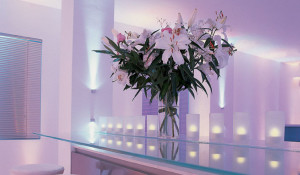The halogen lamp must count as one of the most pervasive lighting products of all time. In fact, even if you think you don’t have halogen lamps in your home, there’s a good chance you probably still do – spot light track in a bathroom perhaps, or the bulb in a reading lamp?
Typically of course they’re recessed into a ceiling void and used to provide ambient down light, which they are very good at and which largely explains their immense popularity.
Why Go With LED Bulbs?
But why, if halogen lamps are so effective, should you seriously consider replacing them all with LED versions?
1. Save yourself a fortune.
Far and way the commonest form of halogen lamp is the 50 watt spot light. Spaced about a meter apart in a ceiling they provide excellent all round light coverage.
But electricity isn’t free of course and you can easily install 20 of these just in a decent sized kitchen, which comes in at a whacking great 1 kilowatt power consumption.
Replace this lot with LED lamps that can do the same job using 6 watts each and you can drop that 1,000 watts right down to 120 watts, with a matching 90% cut in your electricity bill. For most people that’s at least several hundred dollars a year and upwards.
2. Put an end to constantly changing blown bulbs.
The life span for a halogen lamp is about 2,000 hours at best. For an LED it’s about 20,000 hours at worst. Go figure.
3. LEDs are cool.
In both meanings of the word. The look quite funky with more modern metal casings and deliver a slightly whiter light than the pink/yellow hues of halogen.
But they also run cool.
That’s because for a halogen lamp, something like 45 of its total 50 watts power consumption is wasted as heat. The light is an incidental product of heating metal to the point that it actually glows. That’s why LEDs use less power and hence cost less to run – they don’t waste energy as heat.
4. No toxic heavy metals.
This one is for those who may be thinking about switching to Compact Fluorescent Lamps to save energy instead. You do realize that they continue mercury vapor?
Sure, breaking one probably won’t do you any harm – though you are advised to ventilate the area, avoid breathing any fumes and wear protective gloves etc. But a landfill full of them? Nasty.
5. Switching to LED is environmentally beneficial.
Continually replacing a product every couple of thousands hours of use clearly has implications in terms of resources, manufacturing, transport and disposal. A product that can last for a decade or more clearly wins out here.
But the main environmental benefit of LED lighting is that is uses so much less electricity, which in turn means that less coal / oil / uranium / whatever has to be extracted and burned, with all too predictable effects on the atmosphere in particular.
So there you have it – five excellent reasons to switch to LED and if you’re interested in a good in-depth review of LED spot lights then try this article.


